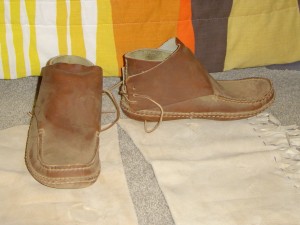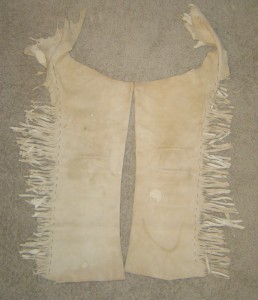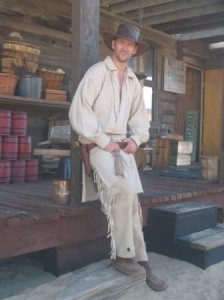I will be hiking in what seems to be pretty standard “Mountain Man” attire: moccasins, breechclout, deerskin leggings, osnaburg shirt, wide-brimmed felt hat.
Footwear
 By all accounts the most common footwear of a 19th Century trapper was deerskin moccasins. These could be made and repaired by the trapper himself with relative ease. However these were never intended for long distance walking—no one in their right mind would choose to walk 1500 miles when a perfectly good equine was available anyway. Government expeditions such as those led by Fremont or Lewis & Clark were either mounted or aboard a craft, so military issue boots were standard. Within a month of setting out, most of the Corps of Discovery had ditched their boots for native style moccasins, a testament to their utility.
By all accounts the most common footwear of a 19th Century trapper was deerskin moccasins. These could be made and repaired by the trapper himself with relative ease. However these were never intended for long distance walking—no one in their right mind would choose to walk 1500 miles when a perfectly good equine was available anyway. Government expeditions such as those led by Fremont or Lewis & Clark were either mounted or aboard a craft, so military issue boots were standard. Within a month of setting out, most of the Corps of Discovery had ditched their boots for native style moccasins, a testament to their utility.
Since I will not have the luxury of a mount or craft, or a steady supply of deerskin from which to fashion new footwear, I decided to go with a decidedly more rugged moccasin made of thick cowhide: Carl Dyer’s “Rendezvous” Moccasin. I hope the thickness and durability of the cowhide will hold up to a serious pounding. I’ve tested them out on some pretty rugged, rocky terrain by my house and they actually performed above my expectation. They fit snug enough to not cause blisters but felt light and supple. They gripped extremely well on dry rock. I didn’t experience any unusual soreness resulting from no insole or arch support. Of course these were 90 minute 3 mile climbs; we’ll see how I feel after weeks on end.
For socks I will wear your basic 100% wool, thick hiking socks from REI. They should provide some nice cushion as well as keep my feet warm at night.
I have looked (unsuccessfully) into having a pair of custom leather sandals made in the style of the Chacos brand. I own a pair of Z/2 hiking sandals and have found them to be the ultimate outdoor footwear. If I could replicate them using a thick durable leather I think I’d have a great hiking shoe that, while dubiously authentic, would still be in the spirit of the trip and offer the best blend of comfort, weight, and utility. If anyone knows an expert leatherworker let me know!
Leggings
 I made my own buckskin leggings using two commercially brain-tanned deer hides and some upholstery thread and these instructions. Initially these were to be a practice pair to help me hone my methods before I spent $400 on real brain tan. I’ve grown somewhat attached to them however, and am getting mixed information on the superiority of real brain tan, so I will likely stick with them for my trip. They’ve held up well on my test hikes, being very supple and soft. It’s like having a second layer of skin. I’m hoping that the increased air flow they provide will help combat any dreaded chafing.
I made my own buckskin leggings using two commercially brain-tanned deer hides and some upholstery thread and these instructions. Initially these were to be a practice pair to help me hone my methods before I spent $400 on real brain tan. I’ve grown somewhat attached to them however, and am getting mixed information on the superiority of real brain tan, so I will likely stick with them for my trip. They’ve held up well on my test hikes, being very supple and soft. It’s like having a second layer of skin. I’m hoping that the increased air flow they provide will help combat any dreaded chafing.
Breechclout
This is still a work in progress. Needless to say it takes a bit of getting used to, but again I’m hoping the increased airflow will actually lead to a drier, more hygienic situation than undies and hiking shorts.
Shirt
I had a very nice shirt made for me by a woman I met at Fort Sutter. It is very similar to the Long Hunter’s Shirt on this site. It’s open in the front like a robe so I close it with a sash. I can then store any number of lightweight objects in the billowy interior of the shirt, above the sash. The fabric is osnaburg, which is a linen-like fabric traditionally from flax or jute, but this one is probably of cotton.
Extras
 I have a pair of 100% silk long underwear that I will bring in case it gets too cold. I doubt such a garment was too common on the frontier, but it certainly existed at the time. I will also bring some leather work-gloves. I am considering a thick flannel shirt or a wool capote for use around camp at night, where I expect it to be quite cool at high altitude.
I have a pair of 100% silk long underwear that I will bring in case it gets too cold. I doubt such a garment was too common on the frontier, but it certainly existed at the time. I will also bring some leather work-gloves. I am considering a thick flannel shirt or a wool capote for use around camp at night, where I expect it to be quite cool at high altitude.
ok,i carry two shirts, three is best. one needs to be wool flannel. plenty of period shirts on the market. a wool blanket wrapped around you is as good as a capote and has more usefulness. two pair of mocs. you are walking, don’t skimp on the footwear. if i were you i would take three pair. the Dyers are a good choice but will be cold and hard in the morning. you should have a pair of heavy “soft’ mocs to walk in also. and a pair of camp mocs for around camp and to sleep in. so you can jump up and tend to your mule that’s tangled up in his ropes. two or three breechclouts, they’re small and don’t take much room. make them out of wool, good wool. it won’t itch. i use wool crepe, you can get it at the fabric store buy plenty, wash it to felt it up then make the breechclout. wool will wick the moisture away and also provide warmth when wet. cotton and linen will chafe when sweaty. i think the Lewis and Clark Expedition allowed 12 pair of mocs for each man. and wore them out. those Dyers are heavy duty and maybe you thought they gripped pretty good, but you will find they are more like skiis then having good traction. the secret to a good moc is to be able to grip with your toes. you can’t do that with those stiff cowhide mocs. pull over shirts will serve better than that open front. you will find it a pain. also a wool knit hat will come in handy to sleep in. keep the head warm and the body will stay warm. on breechclout and leggings,,your pic looks like you are a skinny guy. that’s a good thing. but if your thighs tend to rub together, a breechclout will not be fun. i trek in breechclout and leggings but my legs don’t rub together. those who do have that problem opt for knee breeches and leggings. Bob
What more can I add–your advice is invaluable to me! Why couldn’t you have told me all this stuff last year when I was starting out!? Would have saved a lot of hassle…